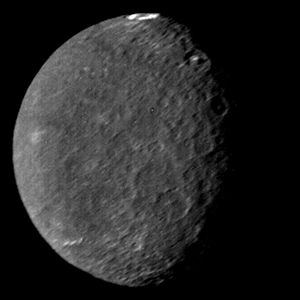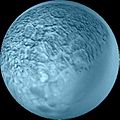Umbriel (moon) facts for kids

Umbriel as seen by Voyager 2 in 1986
|
|||||||||
| Discovery | |||||||||
|---|---|---|---|---|---|---|---|---|---|
| Discovered by | William Lassell | ||||||||
| Discovery date | October 24, 1851 | ||||||||
| Designations | |||||||||
| Pronunciation | UM-bree-əl | ||||||||
| Uranus II | |||||||||
| Adjectives | Umbrielian | ||||||||
| Orbital characteristics | |||||||||
| 266 000 km | |||||||||
| Eccentricity | 0.0039 | ||||||||
| 4.144 d | |||||||||
| Inclination | 0.128° (to Uranus's equator) | ||||||||
| Satellite of | Uranus | ||||||||
| Physical characteristics | |||||||||
|
Mean radius
|
584.7 ± 2.8 km (0.092 Earths) | ||||||||
| 4 296 000 km2 (0.008 Earths) | |||||||||
| Volume | 837 300 000 km3 (0.0008 Earths) | ||||||||
| Mass | 1.172 ± 0.135 × 1021 kg (2 × 10−4 Earths) | ||||||||
|
Mean density
|
1.39 ± 0.16 g/cm3 | ||||||||
| 0.2 m/s2 (~ 0.023 g) | |||||||||
| 0.52 km/s | |||||||||
| presumed synchronous | |||||||||
| 0 | |||||||||
| Albedo |
|
||||||||
|
|||||||||
| 14.5 (V-band, opposition) | |||||||||
| Atmosphere | |||||||||
|
Surface pressure
|
zero | ||||||||
Umbriel is one of the many moons orbiting the planet Uranus. It was discovered on October 24, 1851, by an astronomer named William Lassell. Interestingly, he found Umbriel at the same time he discovered another Uranian moon, Ariel.
Contents
What's in a Name?
The name "Umbriel" was suggested in 1852 by John Herschel. He also suggested the names for the other three moons of Uranus known at that time. Lassell had asked Herschel for help with the names.
Herschel had previously helped Lassell name moons of Saturn. Umbriel is also known as Uranus II.
Exploring Umbriel's Features
So far, we only have close-up pictures of Umbriel from one spacecraft. This was the Voyager 2 probe. It flew past Uranus in January 1986. During this flyby, only the southern part of Umbriel was facing the Sun. This means only that part could be studied closely.
Dark Surface and Craters
Umbriel's surface is the darkest of all the moons around Uranus. It reflects only about half as much light as Ariel, which is Uranus's brightest moon. Umbriel has many more craters than Ariel and Titania. These craters are also much larger. This shows that Umbriel has been the least geologically active moon. This means its surface has changed very little over time.
What Umbriel is Made Of
Umbriel is mostly made of water ice. The rest of it is made of silicate rock. It also contains other types of ice, like methane. When high-energy particles hit methane, it can break down. This forms reddish-black substances called tholins. Special cameras have shown that water ice is the main material on Umbriel's surface.
Naming Craters on Umbriel
Craters on Umbriel are named after different demons from various mythologies. Here are some examples:
| Crater | Named after |
|---|---|
| Alberich | Alberich (Norse) |
| Fin | Fin (Danish) |
| Gob | Gob (Pagan) |
| Kanaloa | Kanaloa (Polynesian) |
| Malingee | Malingee (Australian Aboriginal mythology) |
| Minepa | Minepa (Makua people of Mozambique) |
| Peri | Peri (Persian) |
| Setibos | Setebos (Patagonian) |
| Skynd | Skynd (Danish) |
| Vuver | Vuver (Finnish) |
| Wokolo | Wokolo (Bambara people of West Africa) |
| Wunda | Wunda (Australian Aboriginal mythology) |
| Zlyden | Zlyden (Slavic) |
Images for kids
See also
 In Spanish: Umbriel para niños
In Spanish: Umbriel para niños




